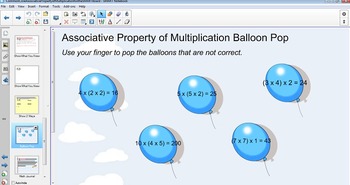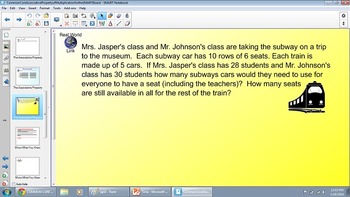Associative Property of Multiplication for the SMART Board
- NOTEBOOK (SMARTboard) File
Description
Associative Property of Multiplication for the SMART Board
This SMART Board Common Core Associative Property of Multiplication interactive lesson helps to demonstrate what the Associative Property of Multiplication is by not only using facts to help convey meaning, but also by using real-world problems as well. SMART File includes real world problems, interactive test prep, an interactive Balloon Pop slide, Math Journal prompts and more!
☰ This product can be imported into Promethean ActivInspire (Click File--->Import--->and choose your SMART Notebook file to open)
HOME SCHOOL USERS: Use the SMART Interactive Viewer
(a FREE SMART Technologies application that will allow you to view and use this file).
Common Core State Standards Addressed:
Operations & Algebraic Thinking
Understand properties of multiplication and the relationship between multiplication and division.
5. Apply properties of operations as strategies to multiply and divide. 2 Examples: If 6 × 4 = 24 is known, then 4 × 6 = 24 is also known. (Commutative property of multiplication.) 3 × 5 × 2 can be found by 3 × 5 = 15, then 15 × 2 = 30, or by 5 × 2 = 10, then 3 × 10 = 30. (Associative property of multiplication.) Knowing that 8 × 5 = 40 and 8 × 2 = 16, one can find 8 × 7 as 8 × (5 + 2) = (8 × 5) + (8 × 2) = 40 + 16 = 56. (Distributive property.)





